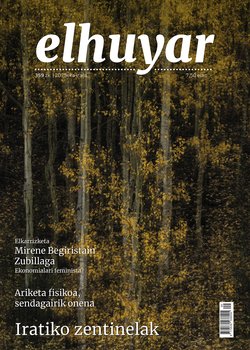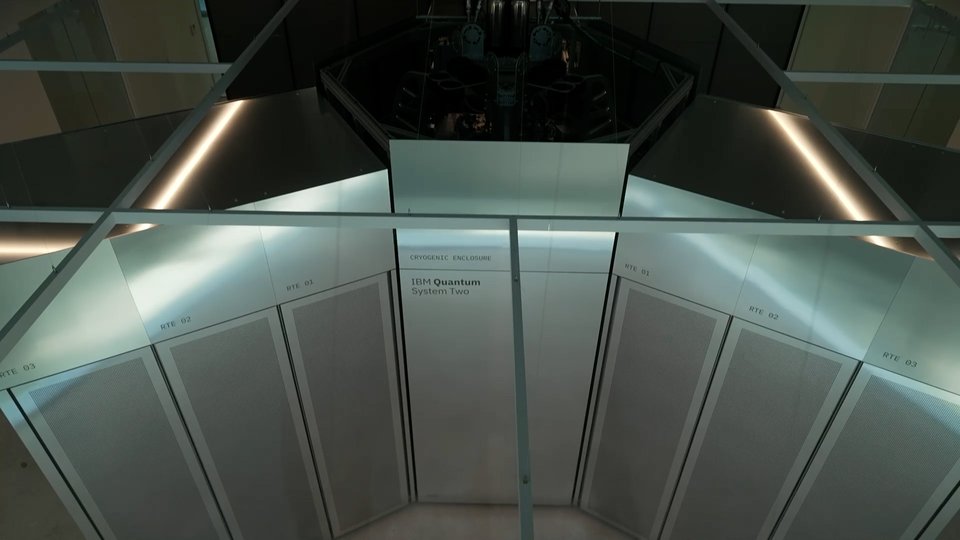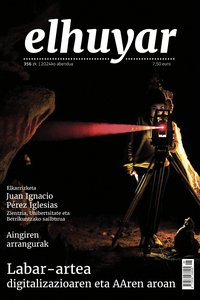Well of dragonflies
The Kutturru Well, Carboneras, Gipuzkoa. In the summer of this year, Iñaki Mezquita from Aranzadi has traveled many times to the Kutturru well. This is an artificial well made last winter, and life is now completely naturalized. Mezquita uses photographic cameras to catalog the species of dragonflies in the well, but even with the naked eye we can easily see who is the master of this well: they are dragonflies.
In fact, this well has been specially built to attract dragonflies.
IÑAKI MEZQUITA; Aranzadi: There are different depths here, right? Then each animal looks for its proper depth. That big shrimp that circulates here, that blue, that's the Anax imperator, it's also called, imperator, it's the biggest dragonfly in Europe, the body reaches 10-11 cm, imagine, and it's usually his behavior from waking up to retiring all the time flying and sending others and so on. Then there are the other smaller species around, Sympetrum and Orthetrum; these are much slower, they fly perfectly, but they usually take care of their land very closely, they don’t fly high and so on. And then you can hardly see those tiny little witch needles walking around here on the margins. They know that they have a party if they walk around here uncovered, and then they always walk around half-sheltered on the margins.
That's about the males. Of course they're females, too. But they walk as far as possible in secret to avoid being seen by the males. But they put the eggs in the water, and that's a good time to see the females. The most impressive is the female Anax imperator, due to its size, among others. He rests on the stains and plants on the edges and lays his eggs with a noticeable inclination of the abdomen.
Other species of dragonflies have different strategies for laying eggs. The female Sympetrum striolatum also lays eggs alone, makes quick touches to the water while flying, and leaves eggs in each of these touches. The male does not walk far; he watches over the performance of the female all the time.
Sympetrum fonscolombi puts the eggs in tandem in the couple. The mating is the same as the rest of the dragonflies, the male grabs the female by the neck with similar hooks on the tail. They form an elegant image when they merge. This is an extraordinary time to observe the morphological differences between males and females of the same species, namely sexual dimorphism. In this case, the male is red-red and the female
is brown. Once covered, the male does not release the female and takes her to her area to lay her eggs there.
The dragonfly makes most of its life in the water: first inside the egg and then as a larva. In general, it covers a cycle of one year. This imperative larva can eat and eat, grow and grow for up to two years by the time it reaches the adult age. During the summer, the larva emerges from the water, climbs up a plant on the edge, and the winged insect, a mature dragonfly, emerges. The hard outer armor stays there. For about a month, the goal of the dragonfly will be to reproduce and survive.
The dragonfly has a fierce daily competition in the well to survive, but the greatest threat is the influence of man.
IÑAKI MEZQUITA; Aranzadi: A lot of work is done; normally, the places where the wetlands are located are very ideal for construction, since they are usually flat places. So, this exploitation has led to a lot of loss. Especially the species in the rivers and those who lived. Rivers have degraded a lot over the years, so their recovery is much more difficult than those that live in slow waters, because those that live in slow waters if you artificially make a well or a pond, being artificial, naturalized, etc., they come and multiply.
However, the state of the dragonfly is not bad, at least not of the species that inhabit the inert waters. Mezquita has catalogued 40 species of dragonflies and witch needles in observations made at 25 points in Gipuzkoa.
IÑAKI MEZQUITA; Aranzadi: 40 species is enough for a small province like ours. You have to think, what can I tell you, that in Bizkaia it is comparable, a little less than in Navarre, but Navarre is very big, it has very different biotopes, Pyrenees, etc., etc. So, I think there is wealth, what has been lost? Especially these river species. These unique and wild species have been lost. So many of the species that circulate here are harsh, of slow waters, especially those of the rivers have been lost quite a bit.
It is easier to prepare suitable dwellings for the species of inert waters. Such as this artificial coal pit gives very good results.
IÑAKI MEZQUITA; Aranzadi: This is the first event this year, so all the possible conquerors have come, for example, and some other one, which is not very normal, has come so soon.
So, I think it's a very nice march.
You only have to see the life that, despite being new, flows into this artificial well, the number of dragonflies that have come to it. Next year, new generations will be born there.
Buletina
Bidali zure helbide elektronikoa eta jaso asteroko buletina zure sarrera-ontzian










